Attached files
| file | filename |
|---|---|
| EX-99.1 - EXHIBIT 99.1 - REGIONS FINANCIAL CORP | rf-20160630xexhibit991.htm |
| EX-99.2 - EXHIBIT 99.2 - REGIONS FINANCIAL CORP | rf-20160630xexhibitx992.htm |
| 8-K - 8-K - REGIONS FINANCIAL CORP | rf-20160630x8k.htm |

2nd Quarter
Earnings
Conference Call
July 19, 2016
Exhibit 99.3
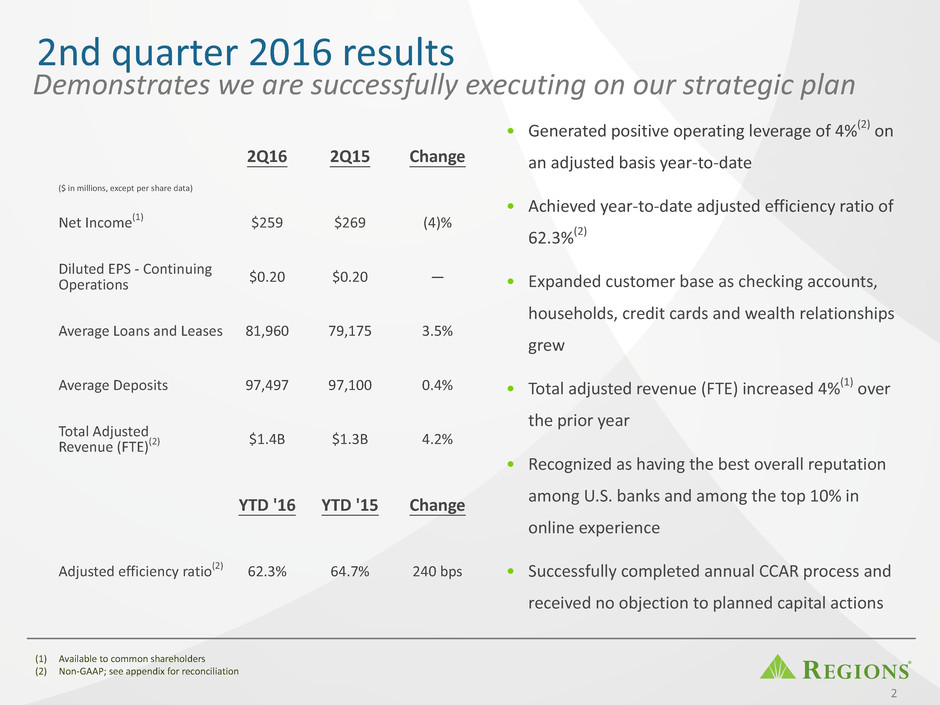
2nd quarter 2016 results
• Generated positive operating leverage of 4%(2) on
an adjusted basis year-to-date
• Achieved year-to-date adjusted efficiency ratio of
62.3%(2)
• Expanded customer base as checking accounts,
households, credit cards and wealth relationships
grew
• Total adjusted revenue (FTE) increased 4%(1) over
the prior year
• Recognized as having the best overall reputation
among U.S. banks and among the top 10% in
online experience
• Successfully completed annual CCAR process and
received no objection to planned capital actions
($ in millions, except per share data)
2Q16 2Q15 Change
Net Income(1) $259 $269 (4)%
Diluted EPS - Continuing
Operations $0.20 $0.20 —
Average Loans and Leases 81,960 79,175 3.5%
Average Deposits 97,497 97,100 0.4%
Total Adjusted
Revenue (FTE)(2) $1.4B $1.3B 4.2%
YTD '16 YTD '15 Change
Adjusted efficiency ratio(2) 62.3% 64.7% 240 bps
(1) Available to common shareholders
(2) Non-GAAP; see appendix for reconciliation
Demonstrates we are successfully executing on our strategic plan
2
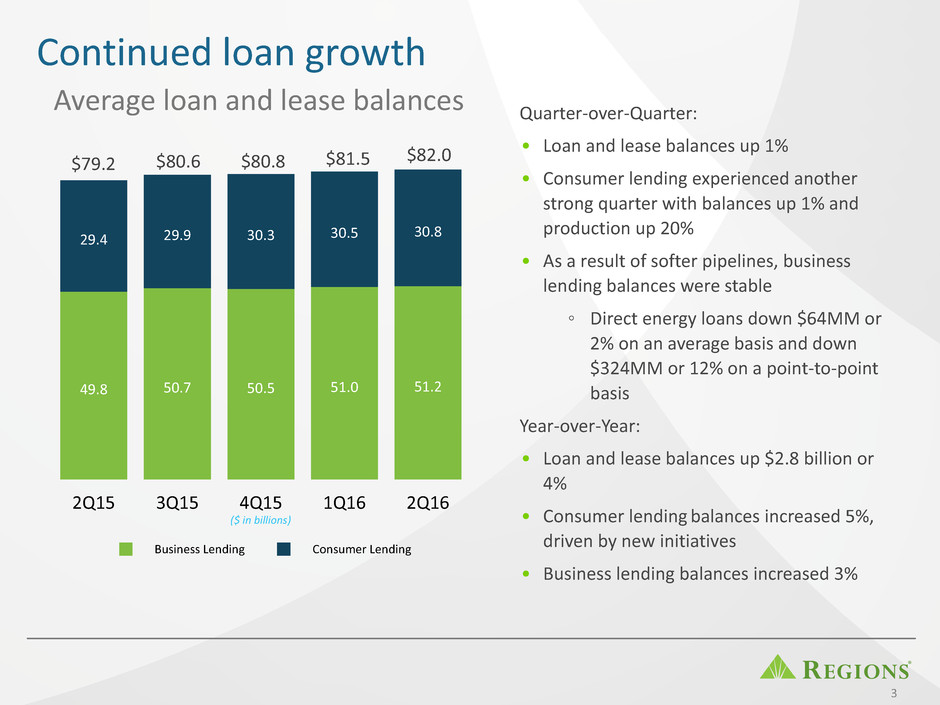
Continued loan growth
Business Lending Consumer Lending
2Q15 3Q15 4Q15 1Q16 2Q16
49.8 50.7 50.5 51.0 51.2
29.4 29.9 30.3 30.5 30.8
($ in billions)
Quarter-over-Quarter:
• Loan and lease balances up 1%
• Consumer lending experienced another
strong quarter with balances up 1% and
production up 20%
• As a result of softer pipelines, business
lending balances were stable
◦ Direct energy loans down $64MM or
2% on an average basis and down
$324MM or 12% on a point-to-point
basis
Year-over-Year:
• Loan and lease balances up $2.8 billion or
4%
• Consumer lending balances increased 5%,
driven by new initiatives
• Business lending balances increased 3%
3
$79.2 $80.6 $80.8 $81.5 $82.0
Average loan and lease balances

Prudently managing deposits; strong growth in
consumer
Low-cost
deposits
Time deposits
+ Other
2Q15 3Q15 4Q15 1Q16 2Q16
88.9 89.1 89.7 90.4 90.2
8.2
$97.1
8.1
$97.2
7.8
$97.5
7.4
$97.8
7.3
$97.5
($ in billions)
4
Consumer
Bank
Corporate
Bank
Wealth
Management
Other
2Q15 3Q15 4Q15 1Q16 2Q16
53.1 52.9 53.0 53.5 54.7
27.2 27.5 27.6 27.6 27.6
12.5 12.3 12.5 12.3 11.3
4.3 4.5 4.4 4.4 3.9
($ in billions)
Quarter-over-Quarter:
• Deposits down $253MM
• Low-cost deposits down $223MM
• Consumer segment deposits increased
2%
• Certain deposits within Wealth
Management and Corporate segments
declined due to planned reductions
• Deposit costs remained near historically
low levels at 12 basis points
• Funding costs remained low at 29 basis
points
Year-over-Year:
• Total deposits up $397MM
• Low-cost deposits up $1.3B or 1.5%
• Consumer deposits increased 3%
Average deposits by type
$97.1 $97.2 $97.5 $97.8 $97.5
Average deposits by segment

Net interest income and other financing income
and net interest margin
Net Interest Income and Other Financing
Income (FTE)
Net Interest Margin
2Q15 3Q15 4Q15 1Q16 2Q16
$839
$855 $856
$883
$869
3.16%
3.13%
3.08%
3.19%
3.15%
Quarter-over-Quarter:
• Net interest income and other financing income
(FTE) down $14MM or 2%
◦ Recent long-term debt issuances, lower loan
fees, reduced dividends from trading assets and
less favorable credit related interest recoveries
were primary drivers behind decrease
◦ Decrease was only partially offset by higher loan
balances
Year-over-Year:
• Net interest income and other financing income
(FTE) up $30MM or 4%
◦ Increase driven primarily by loan growth,
balance sheet hedging and optimization
strategies, and the impact of higher short-term
interest rates
(1) During the fourth quarter of 2015, Regions corrected the accounting for certain leases which had previously been included in loans. The cumulative effect
on pre-tax income lowered net interest income and other financing income $15 million, therefore net interest income and other financing income would
have been $871 million. The correction also reduced the net interest margin by 5 basis points and would have been 3.13%. The company does not expect
this adjustment to have a material impact to net interest income and other financing income or net interest margin in any future reporting period.
($ in millions)
5
(1)
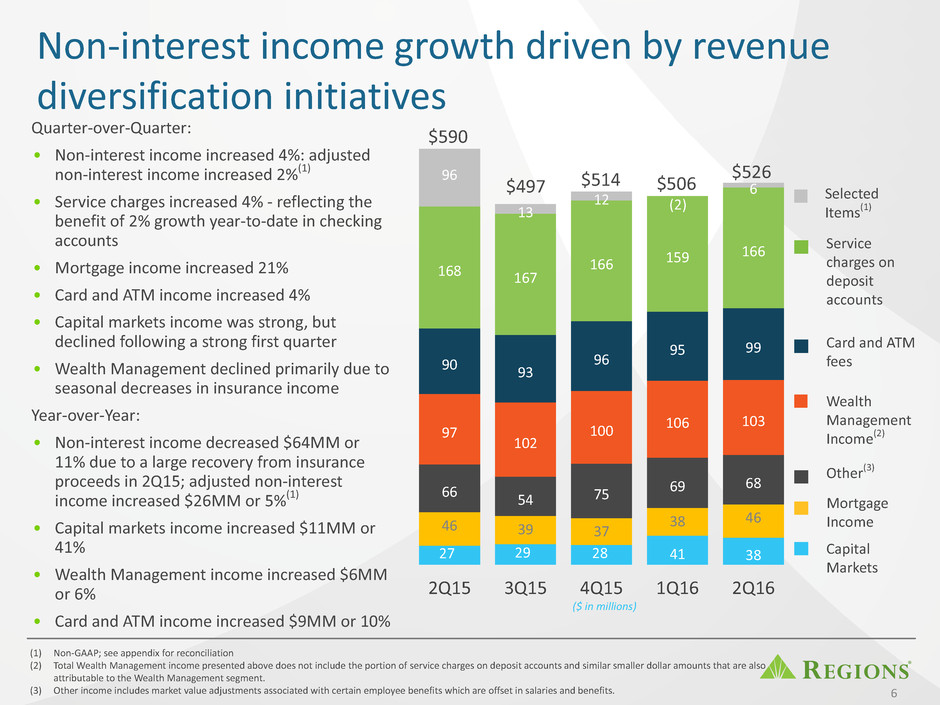
Non-interest income growth driven by revenue
diversification initiatives
2Q15 3Q15 4Q15 1Q16 2Q16
41 38
46 39 37
38 46
66 54 75
69 68
97
102
100 106 103
90 93
96 95
99
168 167
166 159
166
96
13
12
6
590
497
989
514 506
1,000
526
1,182
1,030
(1) Non-GAAP; see appendix for reconciliation
(2) Total Wealth Management income presented above does not include the portion of service charges on deposit accounts and similar smaller dollar amounts that are also
attributable to the Wealth Management segment.
(3) Other income includes market value adjustments associated with certain employee benefits which are offset in salaries and benefits.
Quarter-over-Quarter:
• Non-interest income increased 4%: adjusted
non-interest income increased 2%(1)
• Service charges increased 4% - reflecting the
benefit of 2% growth year-to-date in checking
accounts
• Mortgage income increased 21%
• Card and ATM income increased 4%
• Capital markets income was strong, but
declined following a strong first quarter
• Wealth Management declined primarily due to
seasonal decreases in insurance income
Year-over-Year:
• Non-interest income decreased $64MM or
11% due to a large recovery from insurance
proceeds in 2Q15; adjusted non-interest
income increased $26MM or 5%(1)
• Capital markets income increased $11MM or
41%
• Wealth Management income increased $6MM
or 6%
• Card and ATM income increased $9MM or 10%
$590
$497 $514 Selected
Items(1)
Other(3)
Capital
Markets
Wealth
Management
Income(2)
Mortgage
Income
Card and ATM
fees
Service
charges on
deposit
accounts
($ in millions)
$506
6
(2)
2927 28
$526
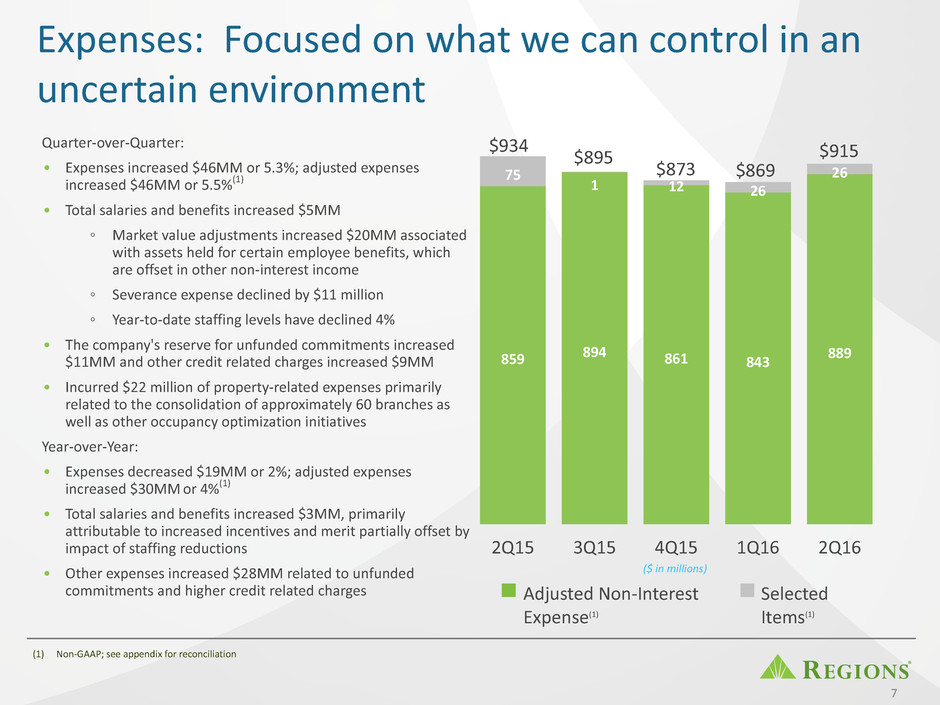
Expenses: Focused on what we can control in an
uncertain environment
2Q15 3Q15 4Q15 1Q16 2Q16
859 894 861 843 889
75
1 12 26
26
Quarter-over-Quarter:
• Expenses increased $46MM or 5.3%; adjusted expenses
increased $46MM or 5.5%(1)
• Total salaries and benefits increased $5MM
◦ Market value adjustments increased $20MM associated
with assets held for certain employee benefits, which
are offset in other non-interest income
◦ Severance expense declined by $11 million
◦ Year-to-date staffing levels have declined 4%
• The company's reserve for unfunded commitments increased
$11MM and other credit related charges increased $9MM
• Incurred $22 million of property-related expenses primarily
related to the consolidation of approximately 60 branches as
well as other occupancy optimization initiatives
Year-over-Year:
• Expenses decreased $19MM or 2%; adjusted expenses
increased $30MM or 4%(1)
• Total salaries and benefits increased $3MM, primarily
attributable to increased incentives and merit partially offset by
impact of staffing reductions
• Other expenses increased $28MM related to unfunded
commitments and higher credit related charges
(1) Non-GAAP; see appendix for reconciliation
($ in millions)
Selected
Items(1)
Adjusted Non-Interest
Expense(1)
$934 $895 $873 $869
7
$915
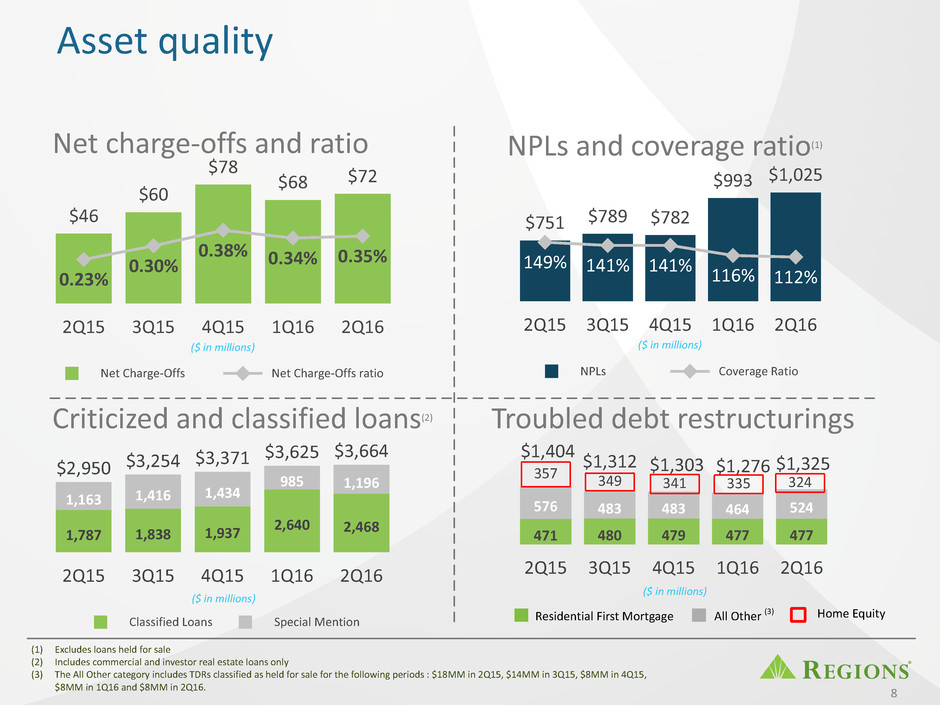
Net Charge-Offs Net Charge-Offs ratio
2Q15 3Q15 4Q15 1Q16 2Q16
$46
$60
$78
$68 $72
0.23%
0.30%
0.38% 0.34% 0.35%
NPLs Coverage Ratio
2Q15 3Q15 4Q15 1Q16 2Q16
$751 $789 $782
$993 $1,025
149% 141% 141% 116% 112%
Classified Loans Special Mention
2Q15 3Q15 4Q15 1Q16 2Q16
1,787 1,838 1,937
2,640 2,468
1,163
$2,950
1,416
$3,254
1,434
$3,371
985
$3,625
1,196
$3,664
2Q15 3Q15 4Q15 1Q16 2Q16
471 480 479 477 477
576 483 483 464 524
Net charge-offs and ratio NPLs and coverage ratio(1)
Criticized and classified loans(2)
(1) Excludes loans held for sale
(2) Includes commercial and investor real estate loans only
(3) The All Other category includes TDRs classified as held for sale for the following periods : $18MM in 2Q15, $14MM in 3Q15, $8MM in 4Q15,
$8MM in 1Q16 and $8MM in 2Q16.
$1,303$1,312
$1,404
357 349 341
Residential First Mortgage All Other (3) Home Equity
($ in millions)
($ in millions)
($ in millions)
($ in millions)
$1,276
335
8
Troubled debt restructurings
$1,325
324
Asset quality
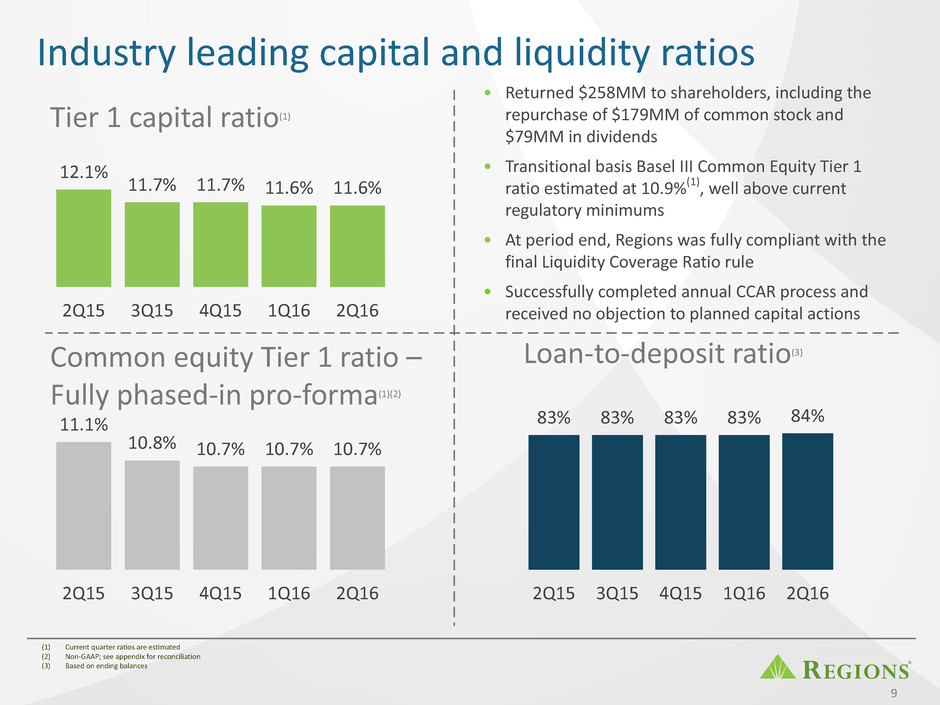
Industry leading capital and liquidity ratios
2Q15 3Q15 4Q15 1Q16 2Q16
12.1%
11.7% 11.7% 11.6% 11.6%
2Q15 3Q15 4Q15 1Q16 2Q16
11.1%
10.8% 10.7% 10.7% 10.7%
2Q15 3Q15 4Q15 1Q16 2Q16
83% 83% 83% 83% 84%
• Returned $258MM to shareholders, including the
repurchase of $179MM of common stock and
$79MM in dividends
• Transitional basis Basel III Common Equity Tier 1
ratio estimated at 10.9%(1), well above current
regulatory minimums
• At period end, Regions was fully compliant with the
final Liquidity Coverage Ratio rule
• Successfully completed annual CCAR process and
received no objection to planned capital actions
(1) Current quarter ratios are estimated
(2) Non-GAAP; see appendix for reconciliation
(3) Based on ending balances
9
Tier 1 capital ratio(1)
Common equity Tier 1 ratio –
Fully phased-in pro-forma(1)(2)
Loan-to-deposit ratio(3)
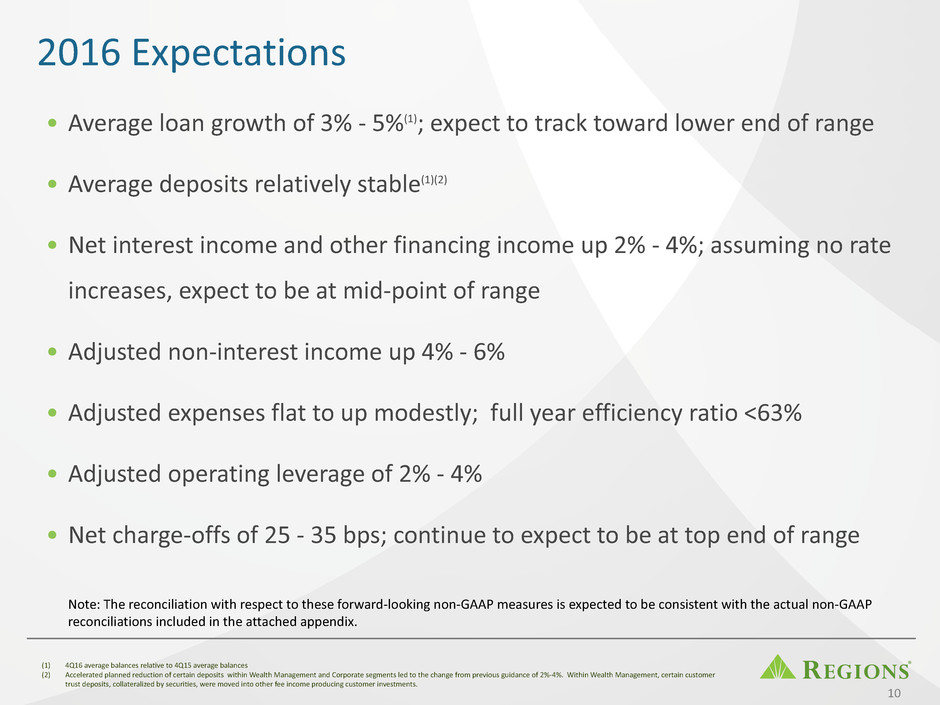
2016 Expectations
• Average loan growth of 3% - 5%(1); expect to track toward lower end of range
• Average deposits relatively stable(1)(2)
• Net interest income and other financing income up 2% - 4%; assuming no rate
increases, expect to be at mid-point of range
• Adjusted non-interest income up 4% - 6%
• Adjusted expenses flat to up modestly; full year efficiency ratio <63%
• Adjusted operating leverage of 2% - 4%
• Net charge-offs of 25 - 35 bps; continue to expect to be at top end of range
Note: The reconciliation with respect to these forward-looking non-GAAP measures is expected to be consistent with the actual non-GAAP
reconciliations included in the attached appendix.
10
(1) 4Q16 average balances relative to 4Q15 average balances
(2) Accelerated planned reduction of certain deposits within Wealth Management and Corporate segments led to the change from previous guidance of 2%-4%. Within Wealth Management, certain customer
trust deposits, collateralized by securities, were moved into other fee income producing customer investments.

Appendix
11
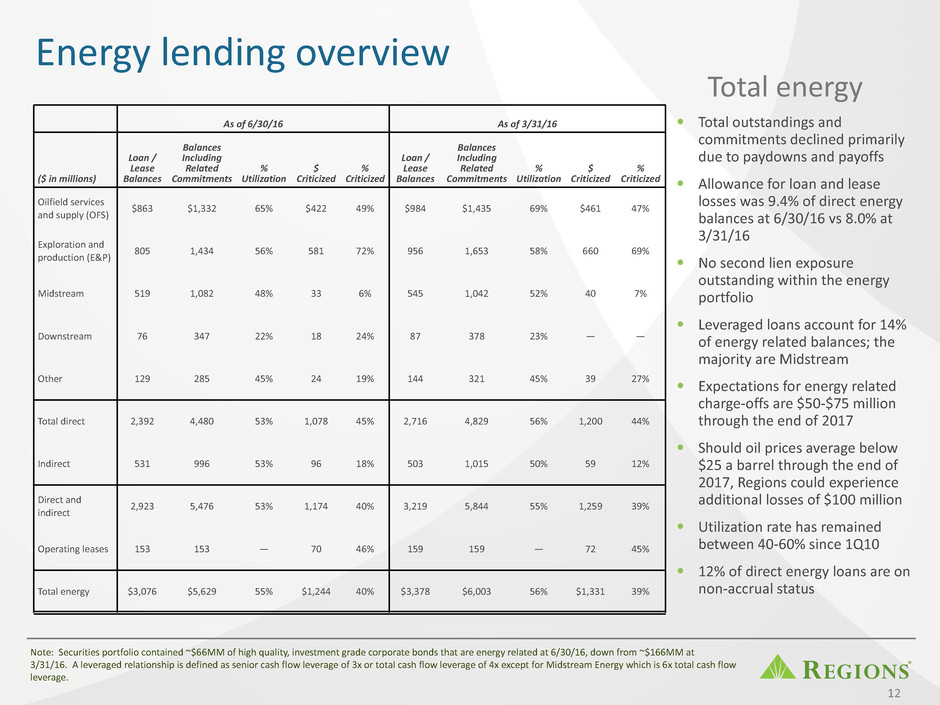
• Total outstandings and
commitments declined primarily
due to paydowns and payoffs
• Allowance for loan and lease
losses was 9.4% of direct energy
balances at 6/30/16 vs 8.0% at
3/31/16
• No second lien exposure
outstanding within the energy
portfolio
• Leveraged loans account for 14%
of energy related balances; the
majority are Midstream
• Expectations for energy related
charge-offs are $50-$75 million
through the end of 2017
• Should oil prices average below
$25 a barrel through the end of
2017, Regions could experience
additional losses of $100 million
• Utilization rate has remained
between 40-60% since 1Q10
• 12% of direct energy loans are on
non-accrual status
Energy lending overview
Total energy
As of 6/30/16 As of 3/31/16
($ in millions)
Loan /
Lease
Balances
Balances
Including
Related
Commitments
%
Utilization
$
Criticized
%
Criticized
Loan /
Lease
Balances
Balances
Including
Related
Commitments
%
Utilization
$
Criticized
%
Criticized
Oilfield services
and supply (OFS) $863 $1,332 65% $422 49% $984 $1,435 69% $461 47%
Exploration and
production (E&P) 805 1,434 56% 581 72% 956 1,653 58% 660 69%
Midstream 519 1,082 48% 33 6% 545 1,042 52% 40 7%
Downstream 76 347 22% 18 24% 87 378 23% — —
Other 129 285 45% 24 19% 144 321 45% 39 27%
Total direct 2,392 4,480 53% 1,078 45% 2,716 4,829 56% 1,200 44%
Indirect 531 996 53% 96 18% 503 1,015 50% 59 12%
Direct and
indirect 2,923 5,476 53% 1,174 40% 3,219 5,844 55% 1,259 39%
Operating leases 153 153 — 70 46% 159 159 — 72 45%
Total energy $3,076 $5,629 55% $1,244 40% $3,378 $6,003 56% $1,331 39%
Note: Securities portfolio contained ~$66MM of high quality, investment grade corporate bonds that are energy related at 6/30/16, down from ~$166MM at
3/31/16. A leveraged relationship is defined as senior cash flow leverage of 3x or total cash flow leverage of 4x except for Midstream Energy which is 6x total cash flow
leverage.
12
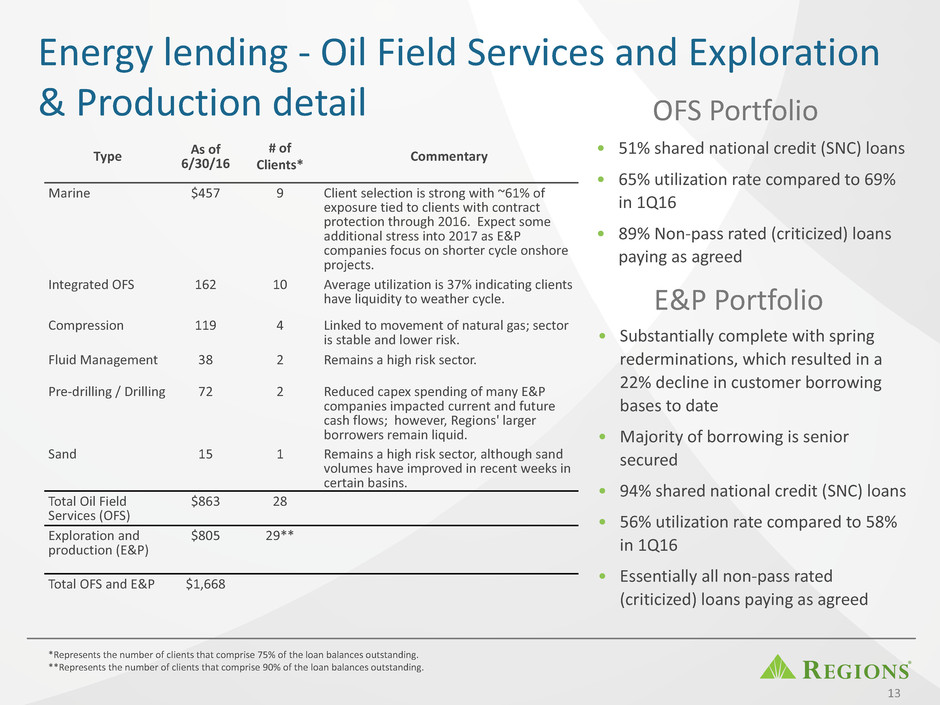
Energy lending - Oil Field Services and Exploration
& Production detail
Type As of6/30/16
# of
Clients* Commentary
Marine $457 9 Client selection is strong with ~61% of
exposure tied to clients with contract
protection through 2016. Expect some
additional stress into 2017 as E&P
companies focus on shorter cycle onshore
projects.
Integrated OFS 162 10 Average utilization is 37% indicating clients
have liquidity to weather cycle.
Compression 119 4 Linked to movement of natural gas; sector
is stable and lower risk.
Fluid Management 38 2 Remains a high risk sector.
Pre-drilling / Drilling 72 2 Reduced capex spending of many E&P
companies impacted current and future
cash flows; however, Regions' larger
borrowers remain liquid.
Sand 15 1 Remains a high risk sector, although sand
volumes have improved in recent weeks in
certain basins.
Total Oil Field
Services (OFS)
$863 28
Exploration and
production (E&P)
$805 29**
Total OFS and E&P $1,668
• 51% shared national credit (SNC) loans
• 65% utilization rate compared to 69%
in 1Q16
• 89% Non-pass rated (criticized) loans
paying as agreed
E&P Portfolio
*Represents the number of clients that comprise 75% of the loan balances outstanding.
**Represents the number of clients that comprise 90% of the loan balances outstanding.
OFS Portfolio
13
• Substantially complete with spring
rederminations, which resulted in a
22% decline in customer borrowing
bases to date
• Majority of borrowing is senior
secured
• 94% shared national credit (SNC) loans
• 56% utilization rate compared to 58%
in 1Q16
• Essentially all non-pass rated
(criticized) loans paying as agreed
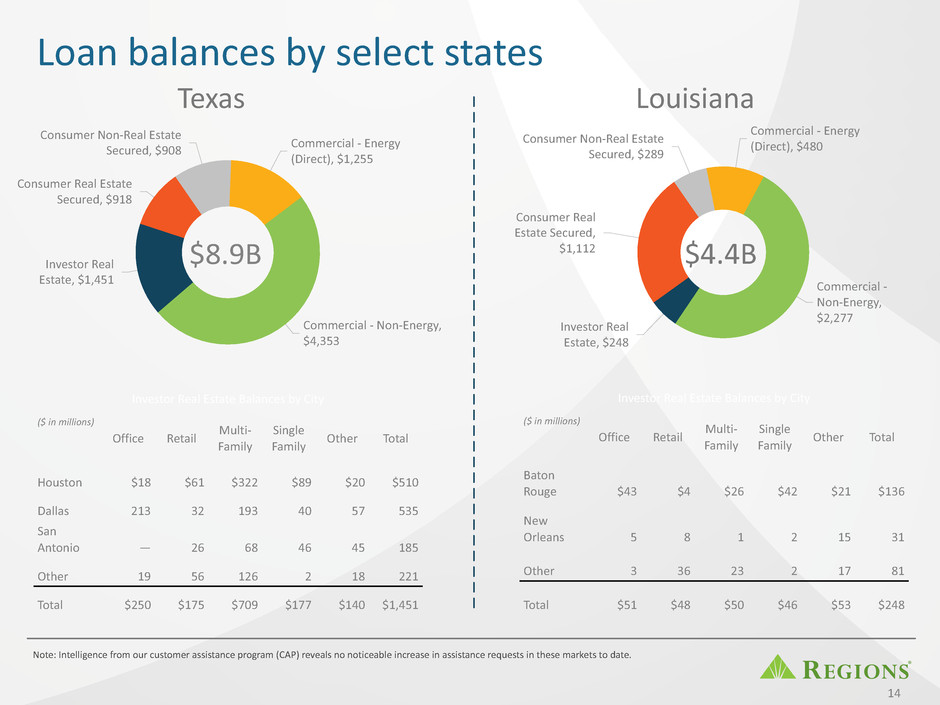
Loan balances by select states
Texas Louisiana
Note: Intelligence from our customer assistance program (CAP) reveals no noticeable increase in assistance requests in these markets to date.
Commercial - Non-Energy,
$4,353
Investor Real
Estate, $1,451
Consumer Real Estate
Secured, $918
Consumer Non-Real Estate
Secured, $908 Commercial - Energy
(Direct), $1,255
Investor Real Estate Balances by City
($ in millions)
Office Retail Multi-Family
Single
Family Other Total
Houston $18 $61 $322 $89 $20 $510
Dallas 213 32 193 40 57 535
San
Antonio — 26 68 46 45 185
Other 19 56 126 2 18 221
Total $250 $175 $709 $177 $140 $1,451
Investor Real Estate Balances by City
($ in millions)
Office Retail Multi-Family
Single
Family Other Total
Baton
Rouge $43 $4 $26 $42 $21 $136
New
Orleans 5 8 1 2 15 31
Other 3 36 23 2 17 81
Total $51 $48 $50 $46 $53 $248
Commercial -
Non-Energy,
$2,277
Investor Real
Estate, $248
Consumer Real
Estate Secured,
$1,112
Consumer Non-Real Estate
Secured, $289
Commercial - Energy
(Direct), $480
14
$4.4B$8.9B
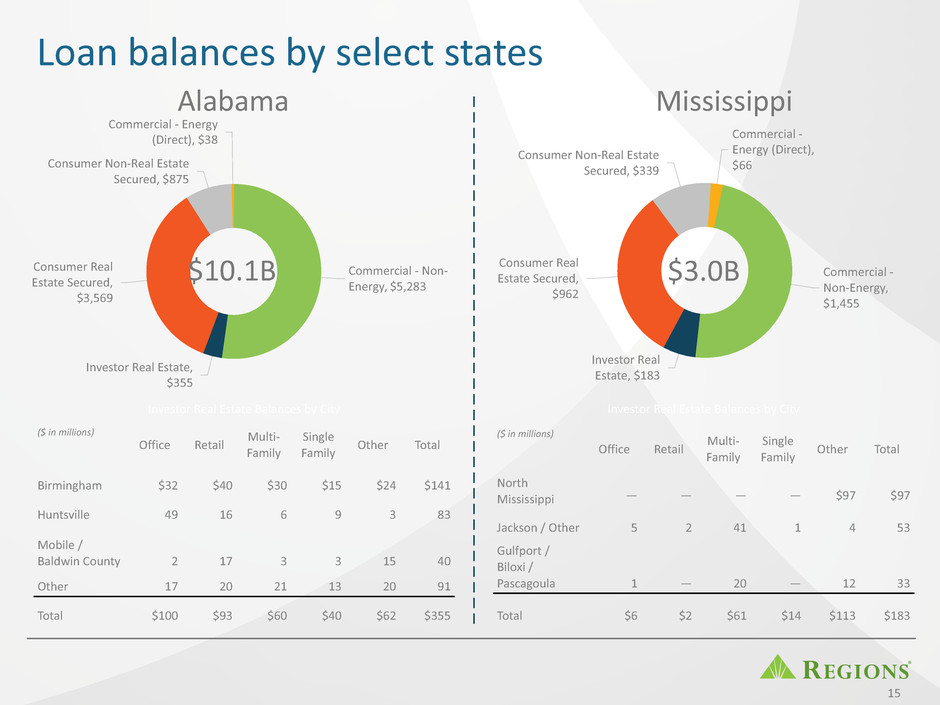
Loan balances by select states
Alabama Mississippi
Commercial - Non-
Energy, $5,283
Investor Real Estate,
$355
Consumer Real
Estate Secured,
$3,569
Consumer Non-Real Estate
Secured, $875
Commercial - Energy
(Direct), $38
Commercial -
Non-Energy,
$1,455
Investor Real
Estate, $183
Consumer Real
Estate Secured,
$962
Consumer Non-Real Estate
Secured, $339
Commercial -
Energy (Direct),
$66
15
$3.0B$10.1B
Investor Real Estate Balances by City
($ in millions)
Office Retail Multi-Family
Single
Family Other Total
Birmingham $32 $40 $30 $15 $24 $141
Huntsville 49 16 6 9 3 83
Mobile /
Baldwin County 2 17 3 3 15 40
Other 17 20 21 13 20 91
Total $100 $93 $60 $40 $62 $355
Investor Real Estate Balances by City
($ in millions)
Office Retail Multi-Family
Single
Family Other Total
North
Mississippi — — — — $97 $97
Jackson / Other 5 2 41 1 4 53
Gulfport /
Biloxi /
Pascagoula 1 — 20 — 12 33
Total $6 $2 $61 $14 $113 $183
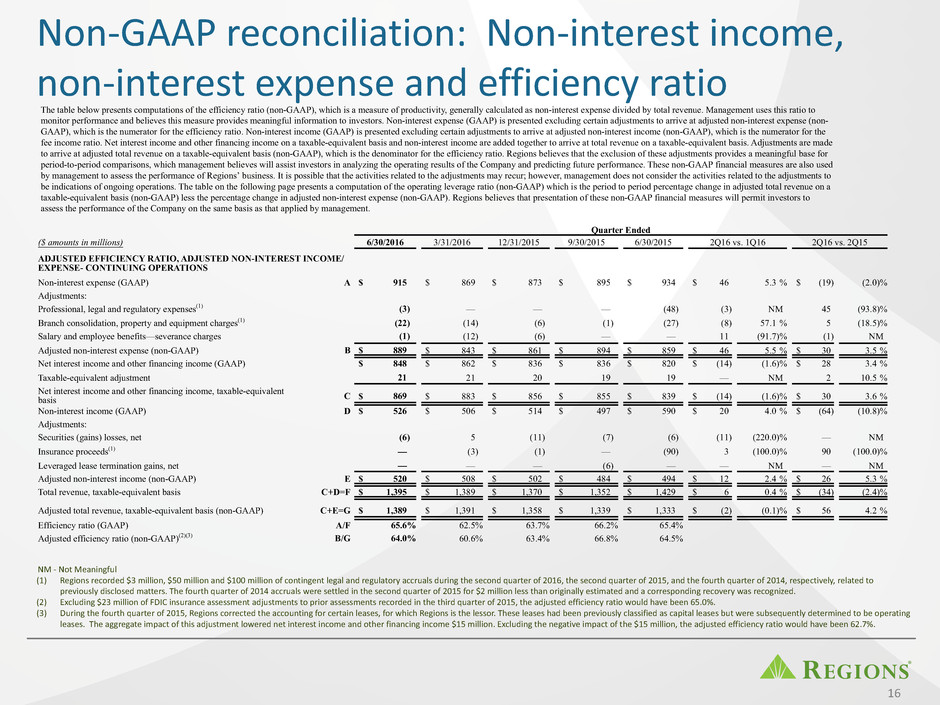
Non-GAAP reconciliation: Non-interest income,
non-interest expense and efficiency ratio
NM - Not Meaningful
(1) Regions recorded $3 million, $50 million and $100 million of contingent legal and regulatory accruals during the second quarter of 2016, the second quarter of 2015, and the fourth quarter of 2014, respectively, related to
previously disclosed matters. The fourth quarter of 2014 accruals were settled in the second quarter of 2015 for $2 million less than originally estimated and a corresponding recovery was recognized.
(2) Excluding $23 million of FDIC insurance assessment adjustments to prior assessments recorded in the third quarter of 2015, the adjusted efficiency ratio would have been 65.0%.
(3) During the fourth quarter of 2015, Regions corrected the accounting for certain leases, for which Regions is the lessor. These leases had been previously classified as capital leases but were subsequently determined to be operating
leases. The aggregate impact of this adjustment lowered net interest income and other financing income $15 million. Excluding the negative impact of the $15 million, the adjusted efficiency ratio would have been 62.7%.
16
Quarter Ended
($ amounts in millions) 6/30/2016 3/31/2016 12/31/2015 9/30/2015 6/30/2015 2Q16 vs. 1Q16 2Q16 vs. 2Q15
ADJUSTED EFFICIENCY RATIO, ADJUSTED NON-INTEREST INCOME/
EXPENSE- CONTINUING OPERATIONS
Non-interest expense (GAAP) A $ 915 $ 869 $ 873 $ 895 $ 934 $ 46 5.3 % $ (19) (2.0)%
Adjustments:
Professional, legal and regulatory expenses(1) (3) — — — (48) (3) NM 45 (93.8)%
Branch consolidation, property and equipment charges(1) (22) (14) (6) (1) (27) (8) 57.1 % 5 (18.5)%
Salary and employee benefits—severance charges (1) (12) (6) — — 11 (91.7)% (1) NM
Adjusted non-interest expense (non-GAAP) B $ 889 $ 843 $ 861 $ 894 $ 859 $ 46 5.5 % $ 30 3.5 %
Net interest income and other financing income (GAAP) $ 848 $ 862 $ 836 $ 836 $ 820 $ (14) (1.6)% $ 28 3.4 %
Taxable-equivalent adjustment 21 21 20 19 19 — NM 2 10.5 %
Net interest income and other financing income, taxable-equivalent
basis C $ 869 $ 883 $ 856 $ 855 $ 839 $ (14) (1.6)% $ 30 3.6 %
Non-interest income (GAAP) D $ 526 $ 506 $ 514 $ 497 $ 590 $ 20 4.0 % $ (64) (10.8)%
Adjustments:
Securities (gains) losses, net (6) 5 (11) (7) (6) (11) (220.0)% — NM
Insurance proceeds(1) — (3) (1) — (90) 3 (100.0)% 90 (100.0)%
Leveraged lease termination gains, net — — — (6) — — NM — NM
Adjusted non-interest income (non-GAAP) E $ 520 $ 508 $ 502 $ 484 $ 494 $ 12 2.4 % $ 26 5.3 %
Total revenue, taxable-equivalent basis C+D=F $ 1,395 $ 1,389 $ 1,370 $ 1,352 $ 1,429 $ 6 0.4 % $ (34) (2.4)%
Adjusted total revenue, taxable-equivalent basis (non-GAAP) C+E=G $ 1,389 $ 1,391 $ 1,358 $ 1,339 $ 1,333 $ (2) (0.1)% $ 56 4.2 %
Efficiency ratio (GAAP) A/F 65.6% 62.5% 63.7% 66.2% 65.4%
Adjusted efficiency ratio (non-GAAP)(2)(3) B/G 64.0% 60.6% 63.4% 66.8% 64.5%
The table below presents computations of the efficiency ratio (non-GAAP), which is a measure of productivity, generally calculated as non-interest expense divided by total revenue. Management uses this ratio to
monitor performance and believes this measure provides meaningful information to investors. Non-interest expense (GAAP) is presented excluding certain adjustments to arrive at adjusted non-interest expense (non-
GAAP), which is the numerator for the efficiency ratio. Non-interest income (GAAP) is presented excluding certain adjustments to arrive at adjusted non-interest income (non-GAAP), which is the numerator for the
fee income ratio. Net interest income and other financing income on a taxable-equivalent basis and non-interest income are added together to arrive at total revenue on a taxable-equivalent basis. Adjustments are made
to arrive at adjusted total revenue on a taxable-equivalent basis (non-GAAP), which is the denominator for the efficiency ratio. Regions believes that the exclusion of these adjustments provides a meaningful base for
period-to-period comparisons, which management believes will assist investors in analyzing the operating results of the Company and predicting future performance. These non-GAAP financial measures are also used
by management to assess the performance of Regions’ business. It is possible that the activities related to the adjustments may recur; however, management does not consider the activities related to the adjustments to
be indications of ongoing operations. The table on the following page presents a computation of the operating leverage ratio (non-GAAP) which is the period to period percentage change in adjusted total revenue on a
taxable-equivalent basis (non-GAAP) less the percentage change in adjusted non-interest expense (non-GAAP). Regions believes that presentation of these non-GAAP financial measures will permit investors to
assess the performance of the Company on the same basis as that applied by management.
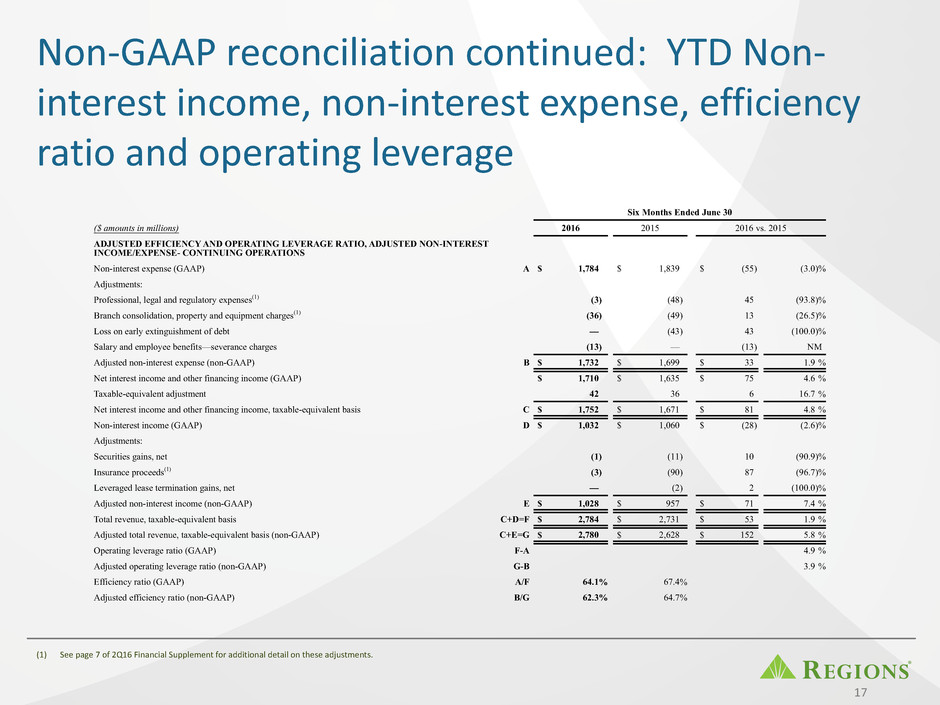
Non-GAAP reconciliation continued: YTD Non-
interest income, non-interest expense, efficiency
ratio and operating leverage
Six Months Ended June 30
($ amounts in millions) 2016 2015 2016 vs. 2015
ADJUSTED EFFICIENCY AND OPERATING LEVERAGE RATIO, ADJUSTED NON-INTEREST
INCOME/EXPENSE- CONTINUING OPERATIONS
Non-interest expense (GAAP) A $ 1,784 $ 1,839 $ (55) (3.0)%
Adjustments:
Professional, legal and regulatory expenses(1) (3) (48) 45 (93.8)%
Branch consolidation, property and equipment charges(1) (36) (49) 13 (26.5)%
Loss on early extinguishment of debt — (43) 43 (100.0)%
Salary and employee benefits—severance charges (13) — (13) NM
Adjusted non-interest expense (non-GAAP) B $ 1,732 $ 1,699 $ 33 1.9 %
Net interest income and other financing income (GAAP) $ 1,710 $ 1,635 $ 75 4.6 %
Taxable-equivalent adjustment 42 36 6 16.7 %
Net interest income and other financing income, taxable-equivalent basis C $ 1,752 $ 1,671 $ 81 4.8 %
Non-interest income (GAAP) D $ 1,032 $ 1,060 $ (28) (2.6)%
Adjustments:
Securities gains, net (1) (11) 10 (90.9)%
Insurance proceeds(1) (3) (90) 87 (96.7)%
Leveraged lease termination gains, net — (2) 2 (100.0)%
Adjusted non-interest income (non-GAAP) E $ 1,028 $ 957 $ 71 7.4 %
Total revenue, taxable-equivalent basis C+D=F $ 2,784 $ 2,731 $ 53 1.9 %
Adjusted total revenue, taxable-equivalent basis (non-GAAP) C+E=G $ 2,780 $ 2,628 $ 152 5.8 %
Operating leverage ratio (GAAP) F-A 4.9 %
Adjusted operating leverage ratio (non-GAAP) G-B 3.9 %
Efficiency ratio (GAAP) A/F 64.1% 67.4%
Adjusted efficiency ratio (non-GAAP) B/G 62.3% 64.7%
(1) See page 7 of 2Q16 Financial Supplement for additional detail on these adjustments.
17
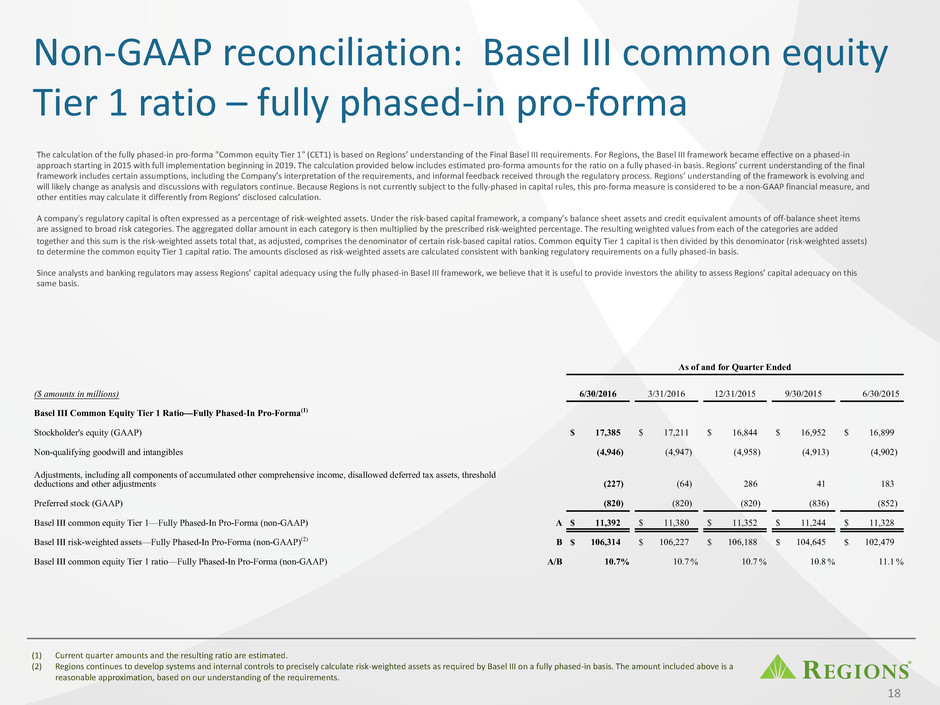
Non-GAAP reconciliation: Basel III common equity
Tier 1 ratio – fully phased-in pro-forma
(1) Current quarter amounts and the resulting ratio are estimated.
(2) Regions continues to develop systems and internal controls to precisely calculate risk-weighted assets as required by Basel III on a fully phased-in basis. The amount included above is a
reasonable approximation, based on our understanding of the requirements.
As of and for Quarter Ended
18
The calculation of the fully phased-in pro-forma "Common equity Tier 1" (CET1) is based on Regions’ understanding of the Final Basel III requirements. For Regions, the Basel III framework became effective on a phased-in
approach starting in 2015 with full implementation beginning in 2019. The calculation provided below includes estimated pro-forma amounts for the ratio on a fully phased-in basis. Regions’ current understanding of the final
framework includes certain assumptions, including the Company’s interpretation of the requirements, and informal feedback received through the regulatory process. Regions’ understanding of the framework is evolving and
will likely change as analysis and discussions with regulators continue. Because Regions is not currently subject to the fully-phased in capital rules, this pro-forma measure is considered to be a non-GAAP financial measure, and
other entities may calculate it differently from Regions’ disclosed calculation.
A company's regulatory capital is often expressed as a percentage of risk-weighted assets. Under the risk-based capital framework, a company’s balance sheet assets and credit equivalent amounts of off-balance sheet items
are assigned to broad risk categories. The aggregated dollar amount in each category is then multiplied by the prescribed risk-weighted percentage. The resulting weighted values from each of the categories are added
together and this sum is the risk-weighted assets total that, as adjusted, comprises the denominator of certain risk-based capital ratios. Common equity Tier 1 capital is then divided by this denominator (risk-weighted assets)
to determine the common equity Tier 1 capital ratio. The amounts disclosed as risk-weighted assets are calculated consistent with banking regulatory requirements on a fully phased-in basis.
Since analysts and banking regulators may assess Regions’ capital adequacy using the fully phased-in Basel III framework, we believe that it is useful to provide investors the ability to assess Regions’ capital adequacy on this
same basis.
($ amounts in millions) 6/30/2016 3/31/2016 12/31/2015 9/30/2015 6/30/2015
Basel III Common Equity Tier 1 Ratio—Fully Phased-In Pro-Forma(1)
Stockholder's equity (GAAP) $ 17,385 $ 17,211 $ 16,844 $ 16,952 $ 16,899
Non-qualifying goodwill and intangibles (4,946) (4,947) (4,958) (4,913) (4,902)
Adjustments, including all components of accumulated other comprehensive income, disallowed deferred tax assets, threshold
deductions and other adjustments (227) (64) 286 41 183
Preferred stock (GAAP) (820) (820) (820) (836) (852)
Basel III common equity Tier 1—Fully Phased-In Pro-Forma (non-GAAP) A $ 11,392 $ 11,380 $ 11,352 $ 11,244 $ 11,328
Basel III risk-weighted assets—Fully Phased-In Pro-Forma (non-GAAP)(2) B $ 106,314 $ 106,227 $ 106,188 $ 104,645 $ 102,479
Basel III common equity Tier 1 ratio—Fully Phased-In Pro-Forma (non-GAAP) A/B 10.7% 10.7 % 10.7 % 10.8 % 11.1 %

Forward-looking statements
This presentation may include forward-looking statements, as defined in the Private Securities Litigation Reform Act of 1995, which reflect Regions’ current views with respect to future events
and financial performance. Forward-looking statements are not based on historical information, but rather are related to future operations, strategies, financial results or other developments.
Forward-looking statements are based on management’s expectations as well as certain assumptions and estimates made by, and information available to, management at the time the
statements are made. Those statements are based on general assumptions and are subject to various risks, uncertainties and other factors that may cause actual results to differ materially
from the views, beliefs and projections expressed in such statements. These risks, uncertainties and other factors include, but are not limited to, those described below:
19
• Current and future economic and market conditions in the United States generally or in the communities we serve, including the effects of declines in property values, unemployment rates and
potential reductions of economic growth, which may adversely affect our lending and other businesses and our financial results and conditions.
• Possible changes in trade, monetary and fiscal policies of, and other activities undertaken by, governments, agencies, central banks and similar organizations, which could have a material adverse effect
on our earnings.
• The effects of a possible downgrade in the U.S. government’s sovereign credit rating or outlook, which could result in risks to us and general economic conditions that we are not able to predict.
• Possible changes in market interest rates or capital markets could adversely affect our revenue and expense, the value of assets and obligations, and the availability and cost of capital and liquidity.
• Any impairment of our goodwill or other intangibles, or any adjustment of valuation allowances on our deferred tax assets due to adverse changes in the economic environment, declining operations of
the reporting unit, or other factors.
• Possible changes in the creditworthiness of customers and the possible impairment of the collectability of loans.
• Changes in the speed of loan prepayments, loan origination and sale volumes, charge-offs, loan loss provisions or actual loan losses where our allowance for loan losses may not be adequate to cover
our eventual losses.
• Possible acceleration of prepayments on mortgage-backed securities due to low interest rates, and the related acceleration of premium amortization on those securities.
• Our ability to effectively compete with other financial services companies, some of whom possess greater financial resources than we do and are subject to different regulatory standards than we are.
• Loss of customer checking and savings account deposits as customers pursue other, higher-yield investments, which could increase our funding costs.
• Our inability to develop and gain acceptance from current and prospective customers for new products and services in a timely manner could have a negative impact on our revenue.
• The effects of any developments, changes or actions relating to any litigation or regulatory proceedings brought against us or any of our subsidiaries.
• Changes in laws and regulations affecting our businesses, such as the Dodd-Frank Act and other legislation and regulations relating to bank products and services, as well as changes in the enforcement
and interpretation of such laws and regulations by applicable governmental and self-regulatory agencies, which could require us to change certain business practices, increase compliance risk, reduce our
revenue, impose additional costs on us, or otherwise negatively affect our businesses.
• Our ability to obtain a regulatory non-objection (as part of the CCAR) process or otherwise) to take certain capital actions, including paying dividends and any plans to increase common stock dividends,
repurchase common stock under current or future programs, or redeem preferred stock or other regulatory capital instruments, may impact our ability to return capital to stockholders and market
perceptions of us.
• Our ability to comply with stress testing and capital planning requirements (as part of the CCAR process or otherwise) may continue to require a significant investment of our managerial resources due
to the importance and intensity of such tests and requirements.
• Our ability to comply with applicable capital and liquidity requirements (including, among other things, the Basel III capital standards and the LCR rule), including our ability to generate capital internally
or raise capital on favorable terms, and if we fail to meet requirements, our financial condition could be negatively impacted.
• The Basel III framework calls for additional risk-based capital surcharges for globally systemically important banks. Although we are not subject to such surcharges, it is possible that in the future we
may become subject to similar surcharges.
• The costs, including possibly incurring fines, penalties, or other negative effects (including reputational harm) of any adverse judicial, administrative, or arbitral rulings or proceedings, regulatory
enforcement actions, or other legal actions to which we or any of our subsidiaries are a party, and which may adversely affect our results.
• Our ability to manage fluctuations in the value of assets and liabilities and off-balance sheet exposure so as to maintain sufficient capital and liquidity to support our business.
• Our ability to execute on our strategic and operational plans, including our ability to fully realize the financial and non-financial benefits relating to our strategic initiatives.
• The success of our marketing efforts in attracting and retaining customers.
• Possible changes in consumer and business spending and saving habits and the related effect on our ability to increase assets and to attract deposits, which could adversely affect our net income.
• Our ability to recruit and retain talented and experienced personnel to assist in the development, management and operation of our products and services may be affected by changes in laws and
regulations in effect from time to time.
• Fraud or misconduct by our customers, employees or business partners.
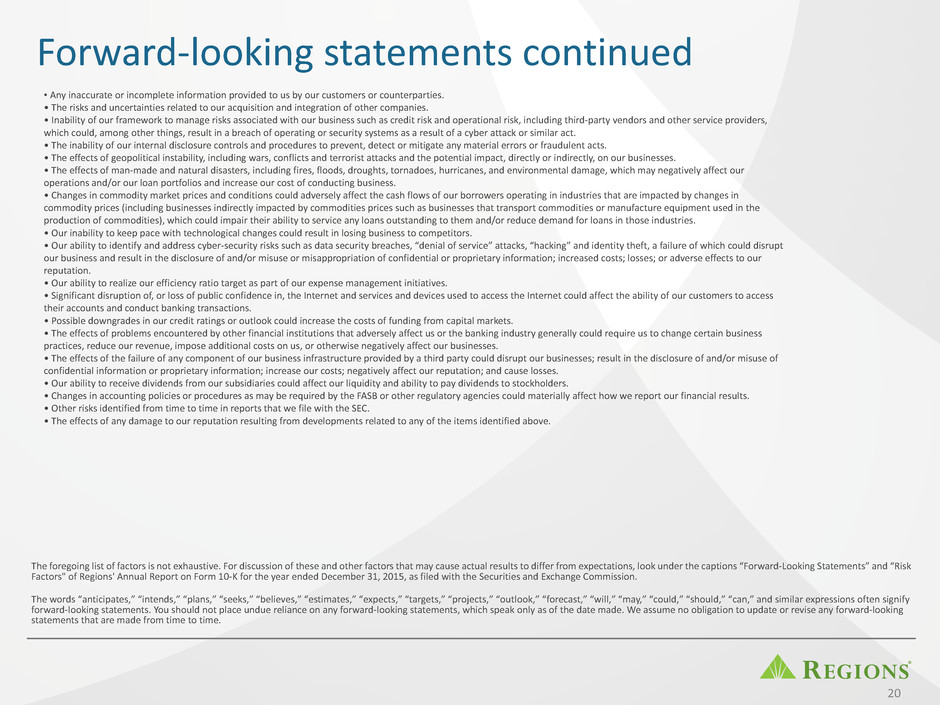
Forward-looking statements continued
The foregoing list of factors is not exhaustive. For discussion of these and other factors that may cause actual results to differ from expectations, look under the captions “Forward-Looking Statements” and “Risk
Factors" of Regions' Annual Report on Form 10-K for the year ended December 31, 2015, as filed with the Securities and Exchange Commission.
The words “anticipates,” “intends,” “plans,” “seeks,” “believes,” “estimates,” “expects,” “targets,” “projects,” “outlook,” “forecast,” “will,” “may,” “could,” “should,” “can,” and similar expressions often signify
forward-looking statements. You should not place undue reliance on any forward-looking statements, which speak only as of the date made. We assume no obligation to update or revise any forward-looking
statements that are made from time to time.
20
• Any inaccurate or incomplete information provided to us by our customers or counterparties.
• The risks and uncertainties related to our acquisition and integration of other companies.
• Inability of our framework to manage risks associated with our business such as credit risk and operational risk, including third-party vendors and other service providers,
which could, among other things, result in a breach of operating or security systems as a result of a cyber attack or similar act.
• The inability of our internal disclosure controls and procedures to prevent, detect or mitigate any material errors or fraudulent acts.
• The effects of geopolitical instability, including wars, conflicts and terrorist attacks and the potential impact, directly or indirectly, on our businesses.
• The effects of man-made and natural disasters, including fires, floods, droughts, tornadoes, hurricanes, and environmental damage, which may negatively affect our
operations and/or our loan portfolios and increase our cost of conducting business.
• Changes in commodity market prices and conditions could adversely affect the cash flows of our borrowers operating in industries that are impacted by changes in
commodity prices (including businesses indirectly impacted by commodities prices such as businesses that transport commodities or manufacture equipment used in the
production of commodities), which could impair their ability to service any loans outstanding to them and/or reduce demand for loans in those industries.
• Our inability to keep pace with technological changes could result in losing business to competitors.
• Our ability to identify and address cyber-security risks such as data security breaches, “denial of service” attacks, “hacking” and identity theft, a failure of which could disrupt
our business and result in the disclosure of and/or misuse or misappropriation of confidential or proprietary information; increased costs; losses; or adverse effects to our
reputation.
• Our ability to realize our efficiency ratio target as part of our expense management initiatives.
• Significant disruption of, or loss of public confidence in, the Internet and services and devices used to access the Internet could affect the ability of our customers to access
their accounts and conduct banking transactions.
• Possible downgrades in our credit ratings or outlook could increase the costs of funding from capital markets.
• The effects of problems encountered by other financial institutions that adversely affect us or the banking industry generally could require us to change certain business
practices, reduce our revenue, impose additional costs on us, or otherwise negatively affect our businesses.
• The effects of the failure of any component of our business infrastructure provided by a third party could disrupt our businesses; result in the disclosure of and/or misuse of
confidential information or proprietary information; increase our costs; negatively affect our reputation; and cause losses.
• Our ability to receive dividends from our subsidiaries could affect our liquidity and ability to pay dividends to stockholders.
• Changes in accounting policies or procedures as may be required by the FASB or other regulatory agencies could materially affect how we report our financial results.
• Other risks identified from time to time in reports that we file with the SEC.
• The effects of any damage to our reputation resulting from developments related to any of the items identified above.

®
21
